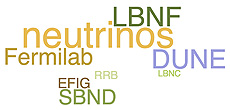NAW alphabet soup
 |
| Do you know what all these terms mean? Read below to find out. |
This week you may find that, no matter which way you turn, you will bump into a neutrino specialist. That is because, through Sept. 6, Fermilab will play host to no fewer than seven meetings attended by scientists all bent on better understanding these subtle particles.
The goal of these neutrino enthusiasts is lofty — nothing less than understanding the universe — but as they take over Wilson Hall and other parts of the laboratory, they bring with them their arcane, obligatory acronyms.
At first we refused to learn their language. Then we realized what a neutrino realizes after traveling 800 miles through the Earth: Not interacting with anyone and ignoring what's going on around you is pretty boring. So we succumbed, learned the lingo and now present you with our translation.
Here is your guide to NAW: Neutrino Action Week.
LBNF/DUNE far-site risk workshop. LBNF is the Long-Baseline Neutrino Facility, a two-part effort based at Fermilab and 800 miles away at Sanford Underground Research Facility in South Dakota. LBNF is the platform for DUNE, the future Deep Underground Neutrino Experiment, which aims to detect many neutrinos and pin down their properties.
Today and tomorrow, scientists on the projects will talk all about risk management at the South Dakota site. The planners have already confirmed that attendance, like a neutrino, is not hazardous to your health.
SBND-DUNE workshop. SBND stands for Short-Baseline Neutrino Detector. It belongs to an international initiative called the Short-Baseline Neutrino program. ("Baseline" refers to the distance neutrinos travel. In the Short-Baseline Neutrino program, the neutrino beam will travel only about 600 meters.) Joining both initiatives is sometimes called base jumping.
SBND is completely separate from DUNE, a long-baseline project, but its neutrino detector shares similar technology and will be used to advance R&D toward DUNE.
DUNE collaboration meeting. See above. The DUNE collaboration is an international group of scientists who are working together to run the world's largest neutrino experiment. They will get together for three and a half days starting Wednesday for some serious face time. (Note: There will be no spice.)
EFIG meeting. The Experiment-Facility Interface Group oversees and ensures coordination during the design phase of LBNF and DUNE. They will continue to do so during the construction and operation phases.
They will meet at Fermilab only for a few hours on Wednesday, so if you blink, you may miss them. But that's OK. EFIG members oscillate into other roles when they attend other NAW meetings, so they may yet be visible to you.
RRB meeting. The Resources Review Board is composed of representatives from all the funding agencies that sponsor LBNF and DUNE and from Fermilab management. The RRB provides focused monitoring and detailed oversight of each of the projects.
They will meet at Fermilab for an afternoon on Thursday. No word yet on whether RRB will meet at Arby's after work.
LBNF-LBNC meeting. LBNF: See above. LBNC: Long-Baseline Neutrino Committee. The LBNC oversees the design, construction and delivery of LBNF. On Thursday the oversight committee will meet with the overseen. Will anything be overturned?
LBNC meeting. See above. Last we checked, the LBNC were to discuss the FSF, FSCF, ESH, FD and ND. Presumably they preferred to discuss these topics away from LBNF, on a Saturday and Sunday.
Of course, if you have free time this week, don't forget that there is also an ISO/OHSAS meeting!
If the neutrino knew it was going to receive this much attention, perhaps it would have worked harder to make itself more scarce. Happy Neutrino Action Week, Fermilab!
|